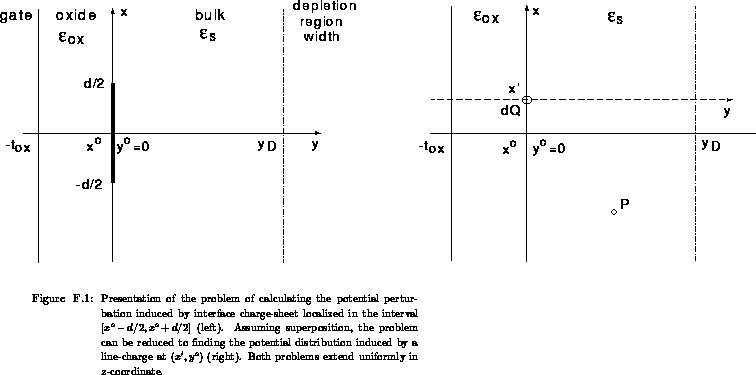Appendix F: Theoretical Consideration of the Potential Perturbation Induced by Localized Surface Charge




Next: F.1 Local Potential Perturbation
Up: PhD Thesis Predrag Habas
Previous: Appendix E: Analytical Modeling of
In Section 3.5 we have found that the shift on the
voltage axis produced by a localized interface charge is smaller than that
corresponding to a uniform interface charge (demonstrated in
Figure 3.24). A rigorous analytical formulation of this
effect is introduced in this appendix. The theoretical expressions are compared
with the two-dimensional numerical calculations. Agreement and deviations
between analytical and numerical models are argued in detail.
It is not possible to develope a rigorous analytical model of this effect in the
general case. For instance, the effect is also influenced by the current flow.
When adopting vanishing minority and majority-carrier currents, the problem
reduces to the Poisson equation solely, which is a nonlinear equation upon
the potential. For the charge pumping conditions considered in
Section 3.5, the carrier concentrations at the interface
typically satisfy the inequalities:  ,
,  , where
, where  is
the bulk doping. Motivated by this fact, in order to be able to derive a
theoretical expression, a total depletion approximation is assumed to hold in
the active part of the bulk. A possible influence of the moving charge will
be noted when comparing theory with numerical results.
is
the bulk doping. Motivated by this fact, in order to be able to derive a
theoretical expression, a total depletion approximation is assumed to hold in
the active part of the bulk. A possible influence of the moving charge will
be noted when comparing theory with numerical results.
Two problems can be formulated:
- to find the potential perturbation induced by a localized charge at the
oxide/bulk interface,
- to find the change in the gate bias necessary to produce the same
conditions in the bulk close to a specific interface point where traps
reside, as the conditions holding at this point when the traps are absent.
It is worth to stress that, although similar at glance, these two viewpoints
are not equivalent to each other. For example, the width of the depletion
region changes comparing the absence and the presence of the traps in the latter
problem, contrary to the former problem, where it remains almost the same in
both cases. To interpret typical measurements of the voltage shift in the
engineering practice, like measurements mentioned in
Section 3.5, the second problem is the one to be dealt
with.





Next: F.1 Local Potential Perturbation
Up: PhD Thesis Predrag Habas
Previous: Appendix E: Analytical Modeling of
Martin Stiftinger
Sat Oct 15 22:05:10 MET 1994
 ,
,  , where
, where  is
the bulk doping. Motivated by this fact, in order to be able to derive a
theoretical expression, a total depletion approximation is assumed to hold in
the active part of the bulk. A possible influence of the moving charge will
be noted when comparing theory with numerical results.
is
the bulk doping. Motivated by this fact, in order to be able to derive a
theoretical expression, a total depletion approximation is assumed to hold in
the active part of the bulk. A possible influence of the moving charge will
be noted when comparing theory with numerical results.




